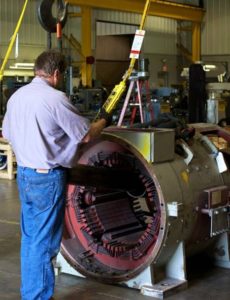Electric Motor Reconditioning: Why and How
 Plant reliability has many facets, including the planned removal and reconditioning of critical electric motors and other electromechanical equipment. There are a host of benefits to reconditioning, but scheduled reconditions are most advised. For example, scheduled reconditioning provides for plant control over when the shutdown occurs, thus reducing costly downtime and related complications. If a plant is committed to increasing facility reliability, then it is time to consider planned motor reconditions.
Plant reliability has many facets, including the planned removal and reconditioning of critical electric motors and other electromechanical equipment. There are a host of benefits to reconditioning, but scheduled reconditions are most advised. For example, scheduled reconditioning provides for plant control over when the shutdown occurs, thus reducing costly downtime and related complications. If a plant is committed to increasing facility reliability, then it is time to consider planned motor reconditions.
The Importance of Removal and Recondition
Every motor is going to reach a point where efficiency begins to decline. With use, wear parts, insulation and other factors degrade. While these use issues may not result in near term failure, running an inefficient motor affects overall plant performance. Ultimately, inefficiency results in failure. Electric motor reconditioning allows for planned inspection and refurbishment, allowing a deep-dive into the equipment to return it to a more efficient and reliable state. And this practice applies not just to motors, but to other electromechanical equipment as well.
Why Removal and Recondition Should be Performed
Reconditioning can take a motor that has become inefficient over its operating life and improve reliable performance at significantly improved efficiency. Motors with rolling element bearings have a finite design life, failure to replace the bearings within that period can cause catastrophic failure. Furthermore, a motor recondition not only extends the life of the motor but also reduces its maintenance and operating costs.
Reconditioning also provides an opportunity to have a professional evaluate your motor and make suggestions for optimum operating performance or possibly a carefully engineered redesign that would further enhance performance and reliability for your specific facility. A redesign, could easily result in a reduction in power usage, a much longer mean time between failures, better control of vibration, and less wear on key components such as bearings.
And, keep this in mind: if evaluation during the reconditioning process reveals an older motor that has reached its limits, sourcing a new bolt-in replacement motor can be a challenge, as many new motors are more compact. If these challenges occur, a rewind can return the existing motor to a condition that will exceed the original efficiency rating from the factory. Normal rewinds can put the motor back in service in days or weeks, depending on various factors, versus worst case scenarios of inability to locate a drop-in motor, or worse an engineered redesign from the factory which can take months.
Planned removal and reconditioning leaves you in control over when the motor is pulled and initiates the process of looking at worst-case options prior to the project, rather than experiencing an unexpected failure.
Where Does Motor Reconditioning Fall in the Spectrum of Reliability?
Electric motors are critical to keeping your facility running…both literally and figuratively. When one fails, even if you have a spare on hand, downtime occurs. With no spare on hand, more problems ensue. Motor reconditioning is simply another arrow in the reliability quiver for overall plant reliability. For critical motors, the reliability spectrum can include continuous monitoring, PdMA, Route Vibration, Routine Oil Analysis, Infrared Analysis, Planned Reconditioning and Critical Spare On-Hand Storage.
What is Involved in a Motor Recondition?
Electric motor reconditioning typically begins with initial testing, followed by disassembly. Next, the components are carefully cleaned, which includes steam cleaning and degreasing. Once all parts have been dried in an air-circulating furnace, inspection begins as technicians perform tests and study both electrical and mechanical components.
And, do not forget visual inspections that can reveal problems such as damage from shaft currents, rotor bar burning, rotor bar cage migration, signs of electrical arcing, damage from misalignments, and other types of problems that can be quickly spotted once the components are cleaned.
Individual components such as shafts are evaluated for replacement (and when possible are restored rather than replaced). Sleeve Bearings are replaced or overhauled, and clearance adjustments may be made. Rolling element bearings are replaced. Redesign recommendations and rewinding are often involved and can include adjustments to the axial position of the shaft, grounding rings to prevent shaft currents, cooling measures, and more. In addition, sensors for monitoring speed, temperature, and vibration can be installed in support of your predictive maintenance program.
Prior to assembly, any balance or alignment issues are addressed, along with key steps such as rotor balancing, renewal of carbon brushes, and clearance checks. After assembly, this is followed by thorough testing for performance and functionality. The motor performance is compared to industry standards such as EASA AR100 to ensure you receive a machine that performs as designed. And do not forget that your motor will be repainted to look like new, in addition to running like new. Detailed reporting should accompany any recondition so that you have a record of the specifics of the repair.
Conclusion
Don’t wait until your electric motors fail to think about reconditioning: perform scheduled reconditions so that you can reap the benefits of a motor recondition (such as better performance, reduced energy requirements, improved efficiency, and enhanced reliability) without the problems and cost of unexpected shutdowns.
Hi-Speed Industrial Service is your answer for reconditions you can depend on! We have experience with well-known industrial brands, and we have all the equipment in-house to make your motors better than new. Contact us today to find out what we have to offer you.

